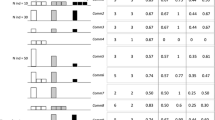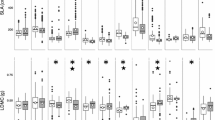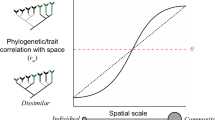Abstract
I explored the effects of sampling on three measures of regional diversity: γ diversity (the number of species), β diversity (mean similarity among sites), and μ diversity (mosaic diversity and structure around mean similarity). Two sampling effects were modelled by computer simulation, number of sites sampled and intensity of sampling within sites, using plant community data from Michigan, North Carolina, and Costa Rica. Estimates of the number of species were sensitive to both sampling effects. Estimates of mean similarity were unaffected by the number of sites sampled but were sensitive to the intensity of sampling. Estimates of mosaic diversity were relatively unaffected by the number of sites sampled, if the number was above 30 sites and outlier sites were removed, and were not sensitive to the intensity of sampling. I offer mean similarity as a multi-gradient complement to β diversity measured as the turnover of species along a single gradient.
Similar content being viewed by others
References
Allen T. F. H. & Starr T. B. 1982. Hierarchy perspectives for ecological complexity. University of Chicago Press. Chicago, IL.
Avena G., Blasi C., Feoli E. & Scoppola A. 1981. Measurement of the predictive value of species lists for species cover in phytosociological samples. Vegetatio 45: 77–84.
Evans F. C. 1952. The influence of size of quadrat on the distributional patterns of plant populations. Contrib. Lab. Vert. Biol. Univ. Mich. 54: 1–15.
Faith D. P. 1983. Asymmetric binary similarity measures. Oecologia 57: 287–290.
Faith D. P., Minchin P. R. & Belbin L. 1987. Compositional dissimilarity as a robust measure of ecological distance. Vegetatio 69: 57–68.
Gleason H. A. 1920. Some applications of the quadrat model. Bull. Torrey Bot. Club 47: 21–33.
Heltshe J. F. 1988. Jackknife estinate of the matching coefficient of similarity. Biometrics 44: 447–460.
Holdridge L. R., Grenke W. C., Hatheway W. H., Liang T. & TosiJr. T. A. 1971. Forest environments in tropical life zones: A pilot study. Pergamon Press, Oxford.
Istock C. A. & Scheiner S. M. 1987. Affinities and high-order diversity within landscape mosaics. Evolutionary Ecology 1: 11–29.
Jaccard P. 1901. Distribution de la flore alpine dans le Bassin des Dranes et dans quelques regions voisines. Bulletin Soc. Vaud. Sci. Nat. 37: 241–272.
Janson S. & Vegelius J. 1981. Measures of ecological association. Oecologia 49: 371–376.
Knox R. G. & Peet R. K. 1989. Bootstrapped ordination: a method for estimating sampling effects in indirect gradient analysis. Vegetatio 80: 153–165.
Miller R. I. & Wiegert R. G. 1989. Documentary completeness, species-area relations, and the species-abundance distribution of a regional flora. Ecology 70: 16–22.
Oosting H. J. 1942. An ecological analysis of the plant communities of Piedmont, North Carolina. Amer. Midl. Nat. 28: 1–126.
Minchin P. R. 1987. An evaluation of the relative robustness of techniques for ecological ordination. Vegetatio 69: 89–107.
Peet R. K. 1974. The measurement of species diversity. Ann. Rev. Ecol. Syst. 5: 285–307.
Routledge R. D. 1984. Estimating ecological components of diversity. Oikos 42: 23–29.
Scheiner S. M. & Istock C. A. 1987. Affinity analysis: methodologies and statistical inference. Vegetatio 72: 89–93.
Whittaker R. H. 1972. Evolution and measurement of species diversity. Taxon 21: 213–251.
Whittaker R. H. 1977. Evolution of species diversity in land communities. In: M. K. Hecht, W. C. Steere & B. Wallace (eds), Evolutionary biology, pp. 1–67. Plenum Publishing Co., N.Y.
Wilson M. V. 1981. A statistical test of the accuracy and consistency of ordinations. Ecology 62: 8–12.
Wilson M. V. & Shmida A. 1984. Measuring beta diversity with presence-absence data. J. Ecol. 72: 1055–1064.
Wolda H. 1981. Similarity indices, sample size, and diversity. Oecologia 50: 296–302.
Author information
Authors and Affiliations
Rights and permissions
About this article
Cite this article
Scheiner, S.M. Affinity analysis: effects of sampling. Vegetatio 86, 175–181 (1990). https://doi.org/10.1007/BF00031733
Accepted:
Issue Date:
DOI: https://doi.org/10.1007/BF00031733




